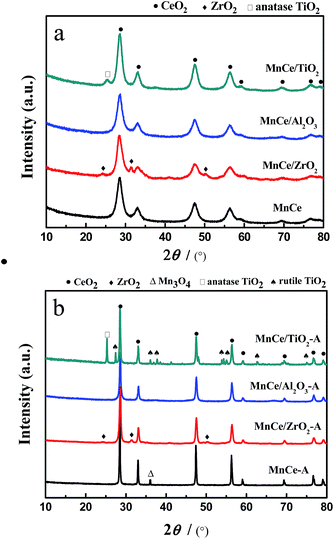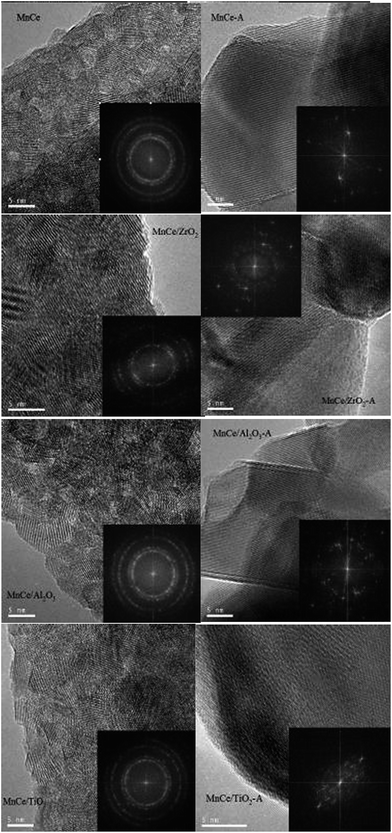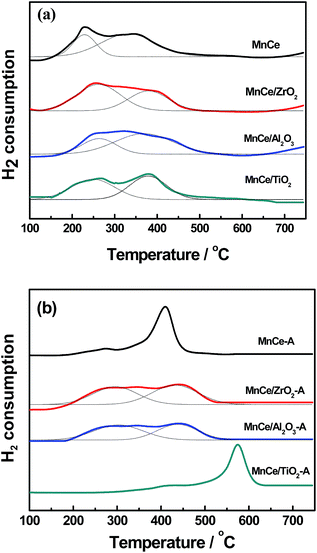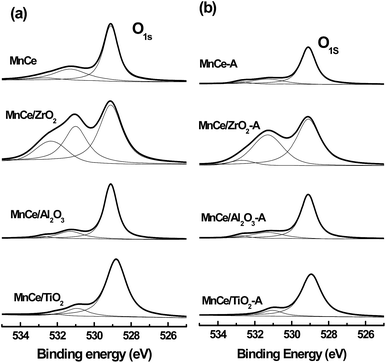Thermal stability of MnOx–CeO2 mixed oxide for soot combustion: influence of Al2O3, TiO2, and ZrO2 carriers
Zhou
Ying
,
Xu
Chenjun
,
Sheng
Yeqing
,
Zhu
Qiuliang
,
Chen
Yinfei
and
Lu
Hanfeng
*
Institute of Catalytic Reaction Engineering, College of Chemical Engineering, Zhejiang University of Technology, Hangzhou 310014, China. E-mail: luhf@zjut.edu.cn; Tel: +86-571-88320767
First published on 22nd October 2015
Abstract
MnOx–CeO2 (Mn/Ce = 0.15/0.85) mixed oxide materials supported on ZrO2, Al2O3, and TiO2 were prepared by citrate sol–gel method to prevent the CeO2-based oxide catalyst from sintering during soot combustion reaction. The materials were characterized using XRD, BET method, HRTEM, H2-TPR, and XPS. Results indicate that the MnOx–CeO2/TiO2 catalyst is rapidly sintered at 800 °C because of the TiO2 phase change from anatase to rutile. By contrast, MnOx–CeO2 catalysts supported on Al2O3 and ZrO2 show high thermal stability. After aging at 800 °C for 10 h, the MnOx–CeO2 crystalline structure remained highly dispersed on the carrier. Particularly with the ZrO2 carrier, the amount of surface oxygen species and redox properties of MnOx–CeO2 can be well-maintained for the synergistic effect of CeO2 and ZrO2 in high temperature environments. Good agreement is found between the low-temperature redox property (200 °C to 400 °C) and the soot combustion activity of the catalysts.
1. Introduction
During the last decade, diesel engines have increased in popularity compared with gasoline engines owing to their superior fuel economy, reliability, and durability. However, emission from diesel engines includes important contaminants, among which particulate matter (PM) is of major concern. PM is mostly composed of carbonaceous soot and a soluble organic fraction of hydrocarbons condensed on the soot. This fraction consists of known harmful compounds that affect human health, as well as produce acid rain and photochemical smog, causing severe environmental problems. Therefore, elimination of PM from the exhaust gases of diesel engine is an important issue for environmental and chemical engineering.1,2 Among various treatments, the combination of a filter and oxidation catalysts is the most widely studied approach to eliminate soot particles. In this combination, soot is initially trapped by diesel particulate filters (DPFs) and then catalytically oxidized to CO2 by catalysts coated on DPFs.3,4Considerable attention has been focused on transition metal-doped ceria mixed oxides because of their high activity for soot combustion, which promotes the mobility of active oxygen at low temperature either by generating solid solutions with more oxygen vacancies or a synergistic effect between transition metals and ceria.5–9 In particular, the incorporation of manganese cations into the ceria lattice markedly enhances the redox property, oxygen storage capacity (OSC), and surface oxygen mobility of ceria, resulting in excellent catalytic performance.9–12 However, a major drawback of the MnOx–CeO2 catalyst is that significant deactivation occurs at above 650 °C, at which the catalyst undergoes dramatic particle sintering and severe phase separation.7,11,13 Thermal stability is a requirement for soot oxidation catalysts, because the temperature inside a DPF can sharply increase as a consequence of the highly exothermal soot combustion process, with temperature gradients of 100 °C cm−1 along both radial and longitudinal directions of the DPF.14–16 Indeed, for promising industrial DPF catalysts, the CeO2-based mixed oxides should maintain the catalytic activity even for aging at 800 °C.7,8
Combination with suitable supports (such as Al2O3,11,17,18 SBA-15,9,19 ZrO2,13,20 TiO2,21–23etc.) is an effective approach to improve the activity and thermal stability of MnOx–CeO2, thereby maintaining the integrity of the MnOx–CeO2 solid solution structure. Strong metal–support interactions are a key factor that determines the catalytic performance of heterogeneous catalysts. Understanding how various support oxides affect the physicochemical properties of CeO2-based mixed oxides is important in selecting appropriate carrier to improve thermal stability. ZrO2, Al2O3, and TiO2, which exhibit a significant impact on activity and stability, are introduced to MnOx–CeO2 mixed oxides as supports with reasonably good chemical stability for soot combustion. This work aims to develop an appropriate support for MnOx–CeO2 mixed oxide systems to attain high thermal stability for soot oxidation, thereby enabling their application in catalytic purification of atmospheric pollutants.
2. Experimental
2.1. Catalyst preparation
ZrO2 and Al2O3 supports were synthesized by precipitation of the corresponding hydroxides (at pH 9 to pH 10) from aqueous solution of Zr(NO3)4·5H2O and Al(NO3)3·9H2O, respectively, by adding diluted ammonia water (drop wise). Precipitates were collected by filtration and washed with deionized water for three times. Then, the precipitates were dried at 110 °C overnight and calcined at 500 °C for 4 h. TiO2 support (SBET = 180 m2 g−1) was supplied by Nanjing Haitai Nano-materials Co., Ltd.MnCe/MOx(MOx = TiO2, Al2O3, and ZrO2) catalysts were prepared by citric acid-assisted sol–gel method with a molar ratio of Mn/Ce = 0.15/0.85 and a weight ratio of (MnOx + CeO2)![[thin space (1/6-em)]](https://www.rsc.org/images/entities/char_2009.gif) :
:![[thin space (1/6-em)]](https://www.rsc.org/images/entities/char_2009.gif) MOx = 2
MOx = 2![[thin space (1/6-em)]](https://www.rsc.org/images/entities/char_2009.gif) :
:![[thin space (1/6-em)]](https://www.rsc.org/images/entities/char_2009.gif) 1, with the corresponding nitrates as precursors. Ce(NO3)3·6H2O and Mn(NO3)2 were dissolved in deionized water and mixed with MOx carrier powders. Two molar equivalents of citric acid were added as a complexing agent. Polyglycol (10 wt% to that of citric acid) was then added. Each solution was stirred and heated until a porous gel is formed. This gel was then dried at 110 °C overnight, decomposed at 300 °C for 1 h, and then calcined at 500 °C for 3 h. For comparison, a MnOx–CeO2 sample was prepared through a similar method with the same Mn/Ce molar ratio. Further thermal treatment was performed on both MnCe/MOx and MnCe samples at 800 °C for 10 h to obtain the aged catalysts with a suffix of “-A”.
1, with the corresponding nitrates as precursors. Ce(NO3)3·6H2O and Mn(NO3)2 were dissolved in deionized water and mixed with MOx carrier powders. Two molar equivalents of citric acid were added as a complexing agent. Polyglycol (10 wt% to that of citric acid) was then added. Each solution was stirred and heated until a porous gel is formed. This gel was then dried at 110 °C overnight, decomposed at 300 °C for 1 h, and then calcined at 500 °C for 3 h. For comparison, a MnOx–CeO2 sample was prepared through a similar method with the same Mn/Ce molar ratio. Further thermal treatment was performed on both MnCe/MOx and MnCe samples at 800 °C for 10 h to obtain the aged catalysts with a suffix of “-A”.
2.2. Catalytic activity measurement
The oxidation of soot (Printex-U provided by Degussa) by the catalysts was studied in a thermogravimetric (TG) analyzer (Netzsch STA 409PC, Germany).24 Activity measurements were obtained under“tight contact” conditions, under which soot–catalyst mixtures with a weight ratio of 1![[thin space (1/6-em)]](https://www.rsc.org/images/entities/char_2009.gif) :
:![[thin space (1/6-em)]](https://www.rsc.org/images/entities/char_2009.gif) 10 were ground in an agate mortar for 10 min. Such conditions allow the activity of the catalysts under optimum conditions to be investigated. Oxidation experiments involved heating each mixture (about 10 mg) at a rate of 10 °C min−1 from 25 °C to 650 °C under a flow of 0.1% NO/N2 (10 mL min−1) and 10% O2/N2 (50 mL min−1). Catalytic activity was evaluated in the following three parameters: (a) the ignition temperature of soot (Ti, the extrapolated starting point of a TG curve); (b) the temperature at which soot oxidation proceeded at the highest rate (Tm, the maximum of a DTG curve); and (c) the burnout temperature of soot (Tf, the extrapolated end point of a TG curve).
10 were ground in an agate mortar for 10 min. Such conditions allow the activity of the catalysts under optimum conditions to be investigated. Oxidation experiments involved heating each mixture (about 10 mg) at a rate of 10 °C min−1 from 25 °C to 650 °C under a flow of 0.1% NO/N2 (10 mL min−1) and 10% O2/N2 (50 mL min−1). Catalytic activity was evaluated in the following three parameters: (a) the ignition temperature of soot (Ti, the extrapolated starting point of a TG curve); (b) the temperature at which soot oxidation proceeded at the highest rate (Tm, the maximum of a DTG curve); and (c) the burnout temperature of soot (Tf, the extrapolated end point of a TG curve).
2.3. Catalyst characterization
Powder X-ray diffraction (XRD) patterns were obtained by a diffractometer (ARLS CINTAG X'TRA) using nickel-filtered Cu Kα radiation and recorded at 0.02° intervals in the range of 10° ≤ 2θ ≤ 80° at a voltage of 45 kV and current of 30 mA. The specific surface areas of samples were determined from N2 adsorption–desorption isotherms, which were measured at −196 °C using the Brunauer–Emmett–Teller (BET) method and a micropore system (ASAP 2020 M, Micromeritics, USA). Samples were pretreated under vacuum at 300 °C for 2 h prior to isotherm measurement.High-resolution transmission electron microscopy (HRTEM, G2 F30 S-Twin, Philips-FEI, the Netherlands) was employed at an accelerating voltage of 300 kV. H2-TPR experiments were conducted using a chemisorption analyzer (FINESORB-3010E, Fine Technology, China). Each sample (200 mg of fresh catalyst) was pretreated at 200 °C for 1 h and subsequently cooled to 80 °C under Ar flow (30 mL min−1). Then, a 5% H2/Ar flow (30 mL min−1) was flowed over the catalyst bed at 80 °C for 20 min, followed by heating at a rate of 10 °C min−1 up to 750 °C. Finally, the catalyst was cooled under an Ar flow (30 mL min−1). H2 consumption was monitored by a thermal conductivity detector operating at 60 °C and 60 mA. X-ray photoelectron spectroscopy (XPS) data were obtained using an Escalab 220i-XL electron spectrometer from VG scientific with 300 W Al Ka. The base pressure was about 3 × 10−9 mbar. The binding energies were referenced to the C 1s line at 284.6 eV from adventitious carbon.
3. Results and discussion
3.1. XRD and BET
The powder XRD patterns of fresh and aged MnCe and MnCe/MOx samples are shown in Fig. 1(a and b), and the lattice constants and mean crystallite sizes of ceria in the samples were calculated by Scherrer equation (Table 1). All patterns of fresh samples are characteristic of fluorite-like cubic structure of ceria with a smaller lattice constant in comparison with that of pure ceria (d lattice ≈ 0.541 nm),25 indicating that Mn–Ce solid solutions are formed by partial replacement of Cex+ (Ce3+ = 0.103 nm, Ce4+ = 0.092 nm) with smaller Mnx+ (Mn2+ = 0.080 nm, Mn3+ = 0.066 nm, Mn4+ = 0.060 nm). In particular, diffraction peaks of monoclinic ZrO2 and anatase TiO2 are detected on MnCe/ZrO2 and MnCe/TiO2, whereas the Al2O3 phase is not found because of its smaller particle size. Notably, the major diffraction peak of CeO2 shifts to a lower angle (2θ = 28.235°) with the introduction of ZrO2.| Sample | 2θ (°) | Lattice constant (Å) | Crystallite size (nm) | A BET (m2 g−1) |
|---|---|---|---|---|
| MnCe | 28.6712 | 5.388 | 7.8 | 78.4 |
| MnCe-A | 28.5840 | 5.404 | 49.9 | <1 |
| MnCe/ZrO2 | 28.2350 | 5.471 | 7.6 | 100.8 |
| MnCe/ZrO2-A | 28.6471 | 5.393 | 23.9 | 31.6 |
| MnCe/Al2O3 | 28.6759 | 5.387 | 9.0 | 94.3 |
| MnCe/Al2O3-A | 28.6336 | 5.401 | 31.2 | 19.5 |
| MnCe/TiO2 | 28.6635 | 5.404 | 7.8 | 96.7 |
| MnCe/TiO2-A | 28.5552 | 5.410 | 41.6 | 5.1 |
In general, the literature data for ZrO2 prepared by ammonia co-precipitation reveals that a diffraction peak of monoclinic ZrO2 appeared at 2θ ≈ 28°.26 Thus, we suggest that a portion of CeO2 particles are cladded by the ZrO2 support, because the special diffraction peak belongs to the overlapping peak of cubic CeO2 and monoclinic ZrO2. The solubility limitation of Mn cations in CeO2 as reported by Kang et al. was 5 mol% to 10 mol%, which depended highly on the preparation procedure.27 This limit is lower than the Mn content in our study (15 mol%). Thus, we can infer the existence of a minimum of two kinds of Mn species in the fresh catalysts, that is, Mn cations in ceria lattice and highly dispersed MnOx clusters on the surface of CeO2 and/or ZrO2, although only typical diffraction peaks of CeO2 are observed in the XRD patterns.
After thermal aging at 800 °C for 10 h, a new diffraction peak of MnCe-A is detected at 2θ = 36.116°. This peak is attributed to tetragonal Mn3O4. Meanwhile, the crystallite size of the MnCe-A sample increases from 8.8 nm to 49.9 nm, accompanied by the reduction of SBET from 78.4 m2 g−1 to about less than 1.0 m2 g−1. This finding implies the severe sintering of the particles and phase separation of Mn–Ce solid solutions. An evident phase transformation of TiO2 from anatase to rutile, as well as crystallite growth and dramatic reduction of surface area, is observed on the MnCe/TiO2-A catalyst. This finding is opposite of the results with the introduction of ZrO2 or Al2O3, which is effective in retarding the phase separation of solid solutions after aging. In particular, a significant increase in lattice constant is noted for MnCe/ZrO2-A as compared with MnCe/ZrO2 and appears to approximate that of the fresh MnCe sample. This finding indicates the separation of the overlapping peak ascribed to cubic CeO2 and monoclinic ZrO2. With respect to Cu–Mn–Ce/ZrO2 mixed oxides, Zr–O–Ce interactions are supposedly involved in the stabilization of the dispersed CeO2 solid solution, which leads to high activity and thermal stability in the total oxidation of toluene.28 Thus, the introduction of the support ZrO2 markedly maintains the high dispersity of the CeO2 phase and itself, as well as prevents the phase separation of MnCe solid solutions. In addition, all supports result in the improvement of surface areas for the corresponding fresh and aged samples as compared with the MnCe catalyst.
3.2. TEM
The TEM and fast Fourier transform (FFT) images of fresh and aged MnCe and MnCe/MOx samples are shown in Fig. 2. The reciprocal of the distance (nm−1) from a certain point to the center in a FFT image has been proven by theoretical studies to be the relevant crystal spacing (nm). This fact is consistent with the result from direct measurement on the TEM image of lattice fringe spacing, but higher precision for large amounts of statistical results for similar crystal facets can be obtained by using the FFT image.29 All FFT images of fresh samples show a quaternary mixed crystal ring, which, from the outside in, corresponds to (311) (d = 0.16 nm), (220) (d = 0.19 nm), and (111) (d = 0.31 nm) surface planes of ceria, respectively. However, high temperature treatment under 800 °C of MnCe-A and MnCe/TiO2-A is shown to induce a rearrangement of crystals, with the dominant lattice plane belonging to the {111}9 families associated with a sharp decrease of the exposure of other facets, such as {311} and {220} planes, which can be still clearly visible in the FFT images of MnCe/ZrO2-A and MnCe/Al2O3-A. Strong evidence provided shows that the surface structure performs a crucial function in the enhancement of OSC and catalytic activity over well-defined ceria nanocrystals. Theoretical results have indicated that the compact {111} surfaces are the most stable,30 and the activity of ceria-based catalysts for numerous reactions, such as ethanol reforming reaction and gas shift reaction, mainly depend on the proportion of non-{111} faces. Following aging and heating of ceria polycrystalline powders, the {111} ceria surface have been shown to undergo structural evolution, and the amount of {111} faces progressively decrease. In comparison, exposure of other faces gradually increases, leading to a higher specific activity for CO oxidation with respect to the fresh samples.31 In general, NOx-assisted soot catalytic oxidation reaction is considered to follow oxygen spillover mechanism,32,33 in which the active surface oxygen spill/transfer over soot in the presence of air, leading to the formation of CO/CO2. In this case, the formation of more oxygen vacancies on the surface of catalysts facilitates OSC enhancement, as lower energy needed to form an oxygen vacancy indicates the higher reactivity of the surface plane toward the reductant molecule. Hence, the ability to form surface vacancy is highly correlated to the type of exposed plane, as shown on MnCe/ZrO2-A and MnCe/Al2O3-A, which maintain a certain number of non-{111} faces.3.3. H2-TPR
Soot combustion in air and on a catalyst proceeds via the “gas (O2)–solid (soot)–solid (catalyst)” three-phase reaction. Several researchers indicated that the effectiveness of the catalyst can be closely related to its ability to better deliver active oxygen to the solid carbon reactant within an appropriate temperature range.24,34 During TPR process, the metallic cations with high valence state are reduced to ions with low valence state or metallic atoms by H2; in addition, lattice oxygen ions are involved in the process because of H2O formation.The images in Fig. 3(a) and (b) exhibit the H2-TPR profiles of fresh and aged samples, respectively. The corresponding H2 consumption of reduction peaks for each catalyst is calculated by integrating the corresponding peak areas with the CuO standard sample (Table 2). For the MnCe mixed oxide, the two peaks at 229 and 331 °C, which are lower than H2-TPR reduction temperature of pure CeO2 and MnOx indicate that the redox property is significantly improved because of the generation of the MnCe solid solution structure. By introducing ZrO2, Al2O3, and TiO2 supports, the reduction peaks of the mixed oxide shift slightly toward higher temperature range. However, the larger areas of the first peak imply an increase in surface adsorbed oxygen species that is attributed to the high dispersion or a synergistic effect between MnOx and CeO2 crystals on the support. In combination with the XRD analysis, the result indicated that the low-temperature redox properties of both MnCe-A and MnCe/TiO2-A samples largely decrease because of particle sintering and phase separation of solid solutions after aging, especially for MnCe/TiO2-A, which undergoes severe phase transformation and encapsulation of MnOx–CeO2 nanoparticles by TiO2. However, high oxygen delivery capacity, which maintains the integrity of Mn–Ce solid solutions, is still observed on MnCe/ZrO2-A and MnCe/Al2O3-A, resulting in relatively stable reducibility.
| Sample | Temperature of peak and H2 consumption (H2-TPR) | T i/°C | T m/°C | T f/°C | |||
|---|---|---|---|---|---|---|---|
| Peak 1 | Peak 2 | ||||||
| T/°C | n(H2)/(mmol g−1) | T/°C | n(H2)/(mmol g−1) | ||||
| MnCe | 229 | 1.021 | 331 | 2.481 | 320 | 368 | 398 |
| MnCe-A | — | — | 408 | 2.234 | 418 | 491 | 542 |
| MnCe/ZrO2 | 254 | 2.312 | 379 | 1.578 | 338 | 390 | 422 |
| MnCe/ZrO2-A | 278 | 2.035 | 431 | 0.936 | 366 | 423 | 468 |
| MnCe/Al2O3 | 263 | 1.059 | 368 | 2.384 | 361 | 412 | 447 |
| MnCe/Al2O3-A | 305 | 1.934 | 445 | 0.757 | 400 | 472 | 516 |
| MnCe/TiO2 | 258 | 1.771 | 377 | 1.727 | 350 | 397 | 431 |
| MnCe/TiO2-A | — | — | 574 | 1.881 | 432 | 525 | 552 |
3.4. XPS characterization
The amount and type of surface oxygen species have been shown to be closely related to the activity of the catalyst. Hence, to investigate the influence of ZrO2 and Al2O3 carriers on the distribution of surface oxygen on the MnCe catalyst, the corresponding fresh and aged samples were characterized by X-ray photoelectron spectroscopy (XPS). As can be noted from Fig. 4, the broad O 1s spectra in all samples indicate the existence of several kinds of surface oxygen species. As is evidently shown by the fitting figures, three different types of oxygen species exist on the surface of all catalysts at the binding energies of ca. 529.2, 531.3, and 532.7 eV, respectively.35 According to the related literature, the oxygen species at the lowest binding energy (ca. 529.2 eV) can be attributed to lattice oxygen, whereas the two species at higher (ca. 532.7 and 531.3 eV) are generally ascribed to superoxide and peroxide, respectively,13,36 which are probably formed via the oxygen adsorption of oxygen vacancies on the reduced surface of catalysts. In an interesting observation noted by comparing Fig. 4(a) with Fig. 4(b), the amount of superoxide and peroxide species of MnCe and MnCe/Al2O3 samples decrease markedly and become substantially less than lattice oxygen under high-temperature treatment. This finding particularly implies a significant reduction of oxygen vacancies that is due to the separation of the solid solution in the MnCe-A sample, whereas the most surface oxygen species can be maintained for the MnCe/ZrO2-A sample. Moreover, instead of reducing, the peroxide species of MnCe/ZrO2-A were increased, indicating transformation from the original superoxide species. We can conclude that the introduction of ZrO2 maintains the integrity of Mn–Ce solid solution structure, as well as the amount of surface oxygen vacancies, which can considerably promote the adsorption of superoxide and peroxide species.3.5. Catalytic activity and overall discussion
The TG and DTG curves of soot combustion over fresh and aged MnCe, MnCe/ZrO2, MnCe/Al2O3, and MnCe/TiO2 catalysts are shown Fig. 5(a–d). The values of Ti, Tm, and Tf, as determined from the curves are summarized in Table 2. Soot oxidation of MnCe sample starts at a low temperature of 320 °C and is completed at 398 °C. However, this catalyst experiences a striking deactivation at high calcination temperature (800 °C) for 10 h. During soot combustion on the MnCe-A sample, the Ti, Tm and Tf shift upwards by more than 100 °C. All fresh supported catalysts exhibit high activities for soot oxidation, with fine dispersion of each support, especially for MnCe/ZrO2 and MnCe/Al2O3 catalysts, as the closeness of two TG/DTG curves for corresponding fresh and aged catalysts indicates higher thermal stability of the catalyst for soot combustion. The lowest thermal stability is observed on TiO2-supported MnCe sample, which is mainly due to the severe sintering of particles, phase transformation of TiO2 and encapsulation of active components. On the contrary, MnCe/ZrO2 and MnCe/Al2O3 catalysts are more resistant toward thermal deactivation. In particular, the Ti, Tm, and Tf of the ZrO2-supported MnCe sample are only increased by 28, 33, and 46 °C, respectively, after extended high-temperature calcination.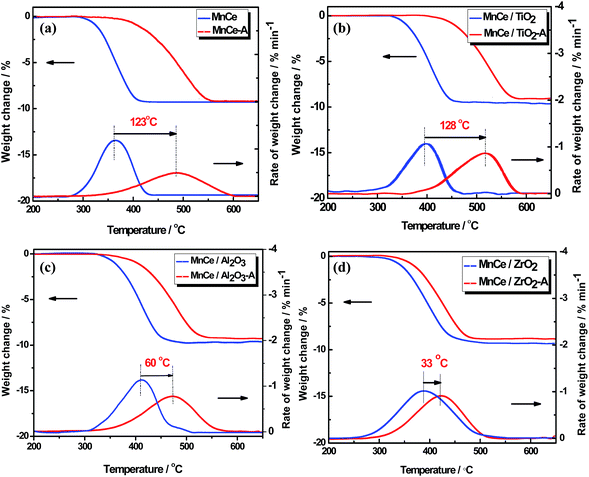 | ||
| Fig. 5 TG and DTG curves of soot/catalyst mixture with fresh and aged (a) MnCe, (b) MnCe/ZrO2, (c) MnCe/Al2O3, and (d) MnCe/TiO2 catalysts. | ||
Our previous study showed that the active oxygen delivery capacity of CeO2 modified by a transition metal at low temperature (200 °C to 400 °C) performs a crucial function in improving catalytic performance by H2-TPR measurement of ceria-based mixed oxides.37 In these oxides, the incorporation of Mn greatly enriches the active oxygen species and bestows high mobility at low temperature, thus contributing to superior catalytic activity. Accordingly, the H2 consumption at 200 °C to 400 °C of fresh and aged MnCe and MnCe/MOx catalysts, which are calculated by integrating the corresponding peak areas with the CuO standard sample, are shown in Fig. 6. A significantly positive correlation is found between soot combustion activity and the released active oxygen (200 °C to 400 °C) of the samples, as the value of Tm gradually increase with the reduction of H2 consumption (200 °C to 400 °C). Among these catalysts, MnCe-A shows almost half of the oxygen delivery capacity (200 °C to 400 °C) as MnCe. In addition, a marked decrease in redox property and activity is exhibited by MnCe/TiO2-A, indicating that TiO2 is not a suitable support for MnCe catalysts for thermal stability improvement. Moreover, Fig. 6 highlights that the H2 consumption variation (200 °C to 400 °C) between MnCe/ZrO2 and MnCe/ZrO2-A is less than 30%, implying that MnCe/ZrO2-A can still provide both larger surface area and richer lattice oxygen in this temperature range.
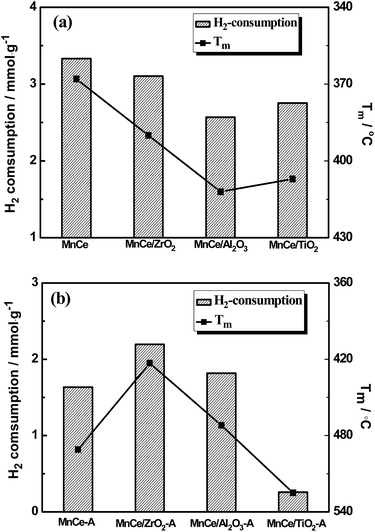 | ||
| Fig. 6 H2 consumption at 200 °C to 400 °C and Tm for soot combustion of (a) fresh MnCe and MnCe/MOx, and (b) aged MnCe and MnCe/MOx catalysts. | ||
Al2O3 and ZrO2 have different mechanisms of action for Mn–Ce oxides. Al2O3 could prevent Mn–Ce migration of nanoparticles by creating an isolation or confinement environment for the active components. However, significant changes in physicochemical properties (such as redox and crystallinity) were still found after aging, although the size did not obviously increase during the aging process. Therefore, the amount of superoxide and peroxide species of MnCe/Al2O3-A samples decreased markedly. However, for ZrO2 carrier, our previous study13 showed that heat treatment leads to the interaction of ZrO2 and CeO2-based oxides via the formation of a new phase, Zr0.88Ce0.12O2, in the interface. Zr0.88Ce0.12O2 appears to function as the actual carrier of the active phase of Cu–Mn–Ce (CMC), which can not only stabilize the surface active structure of CMC, but also enhance the mobility of active oxygen and improve the catalytic performance of total oxidation. Therefore, the higher thermal stability of MnCe/ZrO2 than that of MnCe/TiO2 and MnCe/Al2O3 can be attributed to the synergistic effect of the abundance of the two active oxygen species at low temperature.
4. Conclusion
MnCe/MOx (M = Zr, Al, Ti) catalysts with different supports are compared both in terms of activity and thermal stability for soot combustion. Loading Mn–Ce mixed oxides on ZrO2 was found to be the most effective approach in promoting the thermal stability of oxides. This improvement should be mainly ascribed to restraining the sintering of MnOx and CeO2 crystallites, as well as preventing the phase separation of MnCe solid solutions to a certain extent. Moreover, the thermal stability of MnCe/ZrO2 depends on the proportion of reactive crystal planes (non-{111} planes), the amount and type of surface oxygen species, and the redox capacity after high-temperature treatment at 800 °C for 10 h. In particular, the low-temperature redox property (200 °C to 400 °C) of fresh and aged catalysts is consistent with their soot oxidation activity.Acknowledgements
We would like to acknowledge the financial support from the Natural Science Foundation of China (No. 21107096, 21506194), Zhejiang Provincial Natural Science Foundation of China (No. Y14E080008, Y16B070011), the Commission of Science and Technology of Zhejiang province (No. 2013C03021) and Specialized Research Fund for the Doctoral Program of Higher Education (No. 20133317110004).Notes and references
- B. R. Stanmore, J. F. Brilhac and P. Gilot, Carbon, 2001, 39, 2247–2268 CrossRef CAS.
- R. D. Zhang, N. Luo, B. H. Chen and S. Kaliaguine, Energy Fuels, 2010, 24, 3719–3726 CrossRef CAS.
- K. Yamamoto and T. Sakai, Catal. Today, 2015, 242, 357–362 CrossRef CAS PubMed.
- S. Quiles-Diaz, J. Gimenez-Manogil and A. Garcia-Garcia, RSC Adv., 2015, 5, 17018–17029 RSC.
- M. Piumetti, S. Bensaid, N. Russo and D. Fino, Appl. Catal., B, 2015, 165, 742–751 CrossRef CAS PubMed.
- P. Venkataswamy, D. Jampaiah, K. N. Rao and B. M. Reddy, Appl. Catal., A, 2014, 488, 1–10 CrossRef CAS PubMed.
- S. Liu, X. Wu, D. Weng and R. Ran, J. Rare Earths, 2015, 33, 567–590 CrossRef CAS.
- A. Bueno-Lopez, Appl. Catal., B, 2014, 146, 1–11 CrossRef CAS PubMed.
- H. Zhang, F. Gu, Q. Liu, J. Gao, L. Jia, T. Zhu, Y. Chen, Z. Zhong and F. Su, RSC Adv., 2014, 4, 14879–14889 RSC.
- X. D. Wu, F. Lin, H. B. Xu and D. Weng, Appl. Catal., B, 2010, 96, 101–109 CrossRef CAS PubMed.
- X. Wu, S. Liu, D. Weng, F. Lin and R. Ran, J. Hazard. Mater., 2011, 187, 283–290 CrossRef CAS PubMed.
- X. Wu, S. Liu, D. Weng and F. Lin, Catal. Commun., 2011, 12, 345–348 CrossRef CAS PubMed.
- H. F. Lu, Y. Zhou, W. F. Han, H. F. Huang and Y. F. Chen, Appl. Catal., A, 2013, 464–465, 101–108 CrossRef CAS PubMed.
- G. Zhang, Z. Zhao, J. Xu, J. Zheng, J. Liu, G. Jiang, A. Duan and H. He, Appl. Catal., B, 2011, 107, 302–315 CrossRef CAS PubMed.
- I. Atribak, A. Bueno-Lopez and A. Garcia-Garcia, Catal. Commun., 2008, 9, 250–255 CrossRef CAS PubMed.
- K. Shimizu, M. Katagiri, S. Satokawa and A. Satsuma, Appl. Catal., A, 2011, 108, 39–46 CrossRef PubMed.
- I. Spassova, T. Tsontcheva, N. Velichkova, M. Khristova and D. Nihtianova, J. Colloid Interface Sci., 2012, 374, 267–277 CrossRef CAS PubMed.
- X. Wu, H.-R. Lee, S. Liu and D. Weng, J. Rare Earths, 2012, 30, 659–664 CrossRef CAS.
- F. Z. Zhao, S. F. Ji, P. Y. Wu, Z. F. Li and C. Y. Li, Catal. Today, 2009, 147, S215–S219 CrossRef CAS PubMed.
- H. Li, N. Ta, X. Zhang, X. Huang and W. Shen, Catal. Commun., 2011, 12, 1361–1365 CrossRef CAS PubMed.
- D. Q. Yu, Y. Liu and Z. B. A. Wu, Catal. Commun., 2010, 11, 788–791 CrossRef CAS PubMed.
- B. Murugan and A. V. Ramaswamy, J. Phys. Chem. C, 2008, 112, 20429–20442 CAS.
- Z. Y. Sheng, Y. F. Hu, J. M. Xue, X. M. Wang and W. P. Liao, Environ. Technol., 2012, 33, 2421–2428 CrossRef CAS PubMed.
- L. Katta, P. Sudarsanam, G. Thrimurthulu and B. M. Reddy, Appl. Catal., B, 2010, 101, 101–108 CrossRef CAS PubMed.
- E. Aneggi, M. Boaro, C. de Leitenburg, G. Dolcetti and A. Trovarelli, J. Alloys Compd., 2006, 408, 1096–1102 CrossRef PubMed.
- T. Sreethawong, S. Ngamsinlapasathian and S. Yoshikawa, Chem. Eng. J., 2013, 228, 256–262 CrossRef CAS PubMed.
- C. Y. Kang, H. Kusaba, H. Yahiro, K. Sasaki and Y. Teraoka, Solid State Ionics, 2006, 177, 1799–1802 CrossRef CAS PubMed.
- H. F. Lu, Y. Zhou, W. F. Han, H. F. Huang and Y. F. Chen, Catal. Sci. Technol., 2013, 3, 1480–1484 CAS.
- N. T. Huu, A. Lamacz, P. Beaunier, S. Czajkowska, M. Domanski, A. Krzton, L. Tiep Van and G. Djega-Mariadassou, Appl. Catal., B, 2014, 152, 360–369 Search PubMed.
- M. Nolan, S. Grigoleit, D. C. Sayle, S. C. Parker and G. W. Watson, Surf. Sci., 2005, 576, 217–229 CrossRef CAS PubMed.
- K. Zhou, X. Wang, X. Sun, Q. Peng and Y. Li, J. Catal., 2005, 229, 206–212 CrossRef CAS PubMed.
- P. G. Harrison, I. K. Ball, W. Daniell, P. Lukinskas, M. Cespedes, E. E. Miro and M. A. Ulla, Chem. Eng. J., 2003, 95, 47–55 CrossRef CAS.
- Z. L. Zhang, Y. X. Zhang, Z. P. Wang and X. Y. Gao, J. Catal., 2010, 271, 12–21 CrossRef CAS PubMed.
- B. van Setten, M. Makkee and J. A. Moulijn, Catal. Rev.: Sci. Eng., 2001, 43, 489–564 CAS.
- C. Lee, J.-I. Park, Y.-G. Shul, H. Einaga and Y. Teraoka, Appl. Catal., B, 2015, 174, 185–192 CrossRef PubMed.
- E. Aneggi, N. J. Divins, C. de Leitenburg, J. Llorca and A. Trovarelli, J. Catal., 2014, 312, 191–194 CrossRef CAS PubMed.
- Y. Q. Sheng, Y. Zhou, H. F. Lu, Z. K. Zhang and Y. F. Chen, Chin. J. Catal., 2013, 34, 25–33 Search PubMed.
| This journal is © The Royal Society of Chemistry 2015 |

